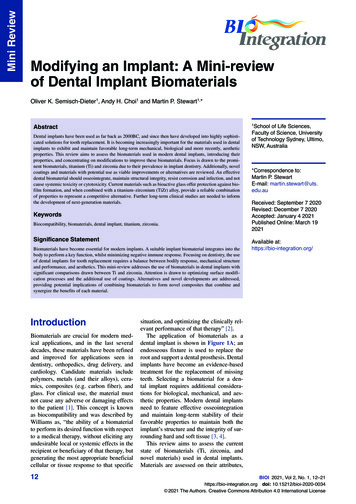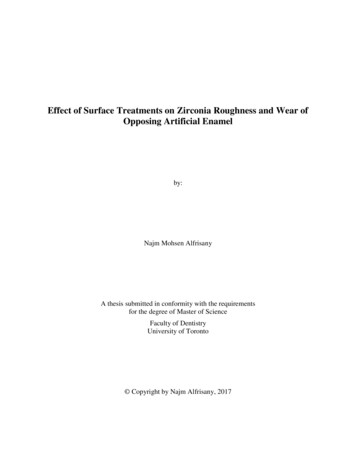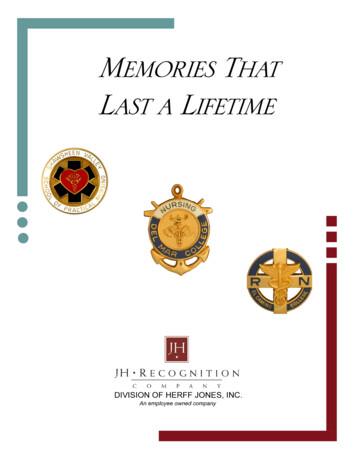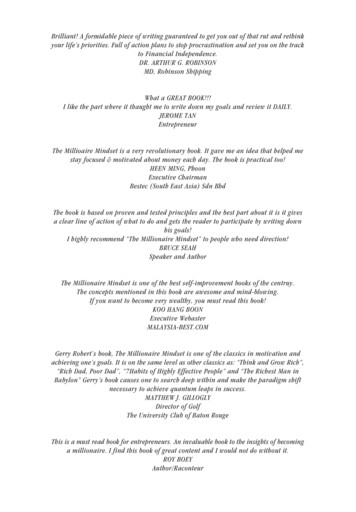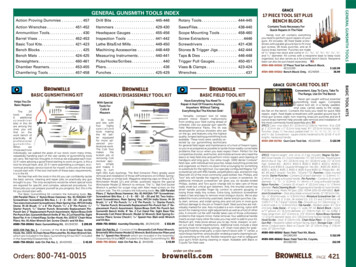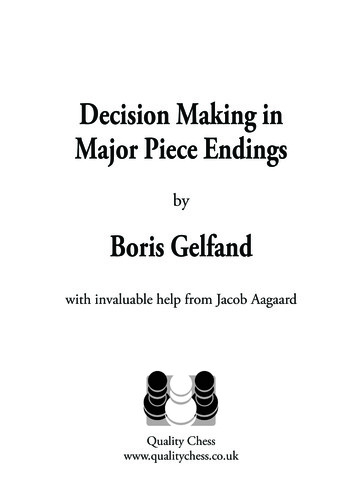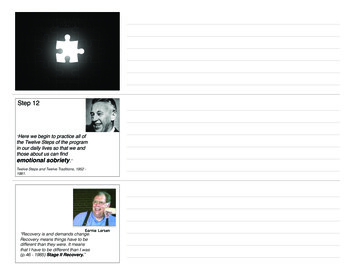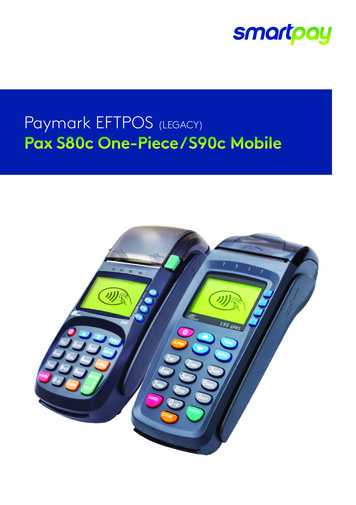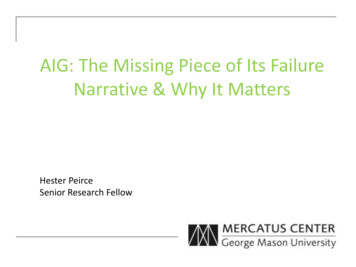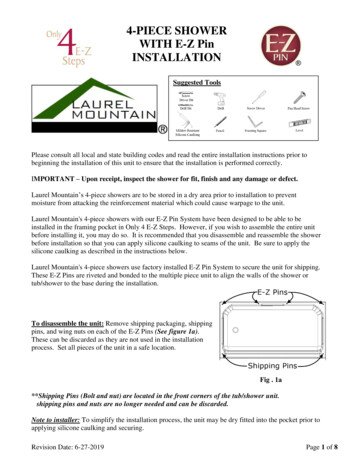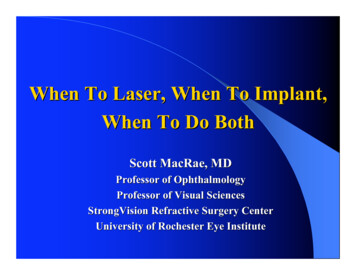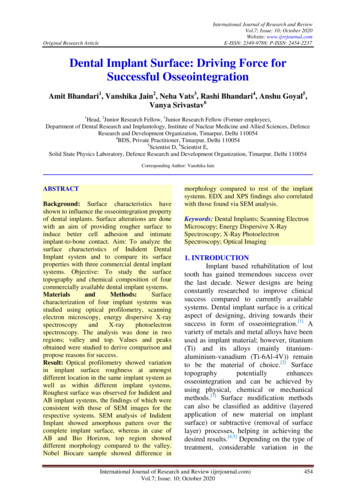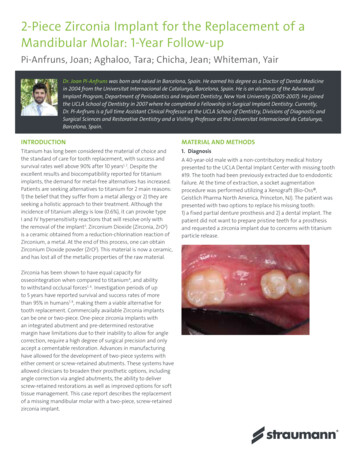
Transcription
2-Piece Zirconia Implant for the Replacement of aMandibular Molar: 1-Year Follow-upPi-Anfruns, Joan; Aghaloo, Tara; Chicha, Jean; Whiteman, YairDr. Joan Pi-Anfruns was born and raised in Barcelona, Spain. He earned his degree as a Doctor of Dental Medicinein 2004 from the Universitat Internacional de Catalunya, Barcelona, Spain. He is an alumnus of the AdvancedImplant Program, Department of Periodontics and Implant Dentistry, New York University (2005-2007). He joinedthe UCLA School of Dentistry in 2007 where he completed a Fellowship in Surgical Implant Dentistry. Currently,Dr. Pi-Anfruns is a full time Assistant Clinical Professor at the UCLA School of Dentistry, Divisions of Diagnostic andSurgical Sciences and Restorative Dentistry and a Visiting Professor at the Universitat Internacional de Catalunya,Barcelona, Spain.INTRODUCTIONMATERIAL AND METHODSTitanium has long been considered the material of choice andthe standard of care for tooth replacement, with success andsurvival rates well above 90% after 10 years1, 2. Despite theexcellent results and biocompatibility reported for titaniumimplants, the demand for metal-free alternatives has increased.Patients are seeking alternatives to titanium for 2 main reasons:1) the belief that they suffer from a metal allergy or 2) they areseeking a holistic approach to their treatment. Although theincidence of titanium allergy is low (0.6%), it can provoke typeI and IV hypersensitivity reactions that will resolve only withthe removal of the implant3. Zirconium Dioxide (Zirconia, ZrO2)is a ceramic obtained from a reduction-chlorination reaction ofZirconium, a metal. At the end of this process, one can obtainZirconium Dioxide powder (ZrO2). This material is now a ceramic,and has lost all of the metallic properties of the raw material.1. DiagnosisA 40-year-old male with a non-contributory medical historypresented to the UCLA Dental Implant Center with missing tooth#19. The tooth had been previously extracted due to endodonticfailure. At the time of extraction, a socket augmentationprocedure was performed utilizing a Xenograft (Bio-Oss ,Geistlich Pharma North America, Princeton, NJ). The patient waspresented with two options to replace his missing tooth:1) a fixed partial denture prosthesis and 2) a dental implant. Thepatient did not want to prepare pristine teeth for a prosthesisand requested a zirconia implant due to concerns with titaniumparticle release.Zirconia has been shown to have equal capacity forosseointegration when compared to titanium4, and abilityto withstand occlusal forces5, 6. Investigation periods of upto 5 years have reported survival and success rates of morethan 95% in humans7, 8, making them a viable alternative fortooth replacement. Commercially available Zirconia implantscan be one or two-piece. One-piece zirconia implants withan integrated abutment and pre-determined restorativemargin have limitations due to their inability to allow for anglecorrection, require a high degree of surgical precision and onlyaccept a cementable restoration. Advances in manufacturinghave allowed for the development of two-piece systems witheither cement or screw-retained abutments. These systems haveallowed clinicians to broaden their prosthetic options, includingangle correction via angled abutments, the ability to deliverscrew-retained restorations as well as improved options for softtissue management. This case report describes the replacementof a missing mandibular molar with a two-piece, screw-retainedzirconia implant.1
2. Treatment PlanAfter 5 months of healing, a CBCT was obtained to assess bone volume and to allow for digital workflow. The DICOM files wereuploaded to a digital planning software (CoDiagnostix , Dental Wings GmbH, Chemnitz, Germany) and the case was planned forguided surgery. A digital scan of the wax up was uploaded to the planning software for proper positioning of the implant. A digitalsurgical guide was generated and produced in a desktop 3D printer (Form 2, Formlabs, Somerville, MA).3. SurgeryAfter obtaining informed consent, the patient was given a pre-operative dose of 2 grams of Amoxicllin and 600mg of Ibuprofen.Local anesthesia was applied via local infiltration utilizing Lidocaine 2% at 1:100.000 Epinephrine. A mid-crestal incision was madeand a full-thickness muco-periosteal flap was released. The surgical guide was seated and drilling protocol was followed as permanufacturers recommendations following a guided protocol. A 4.1 x 10 mm PURE 2-piece Zirconia implant (Straumann , Basel,Switzerland) was placed at 35Ncm. A custom healing abutment was fabricated utilizing a Vita-CAD Temp and tightened to 15Ncm.The site was closed with 4-0 Chromic Gut sutures in a single interrupted fashion. A post-operative peri-apical x-ray taken to verifyseating of the temporary abutment. Post-operative care included Amoxicillin 500mg TID for 7 days and Ibuprofen 600mg q6has needed. The patient was instructed not to function on the left side during the osseointegration period to avoid loading of theimplant.
4. Restorative Phase8 weeks after implant placement, the patient returned to the clinic for final impression procedures. The customized healingabutment was removed, soft tissue was evaluated and a direct customized impression coping was fabricated using a dual cure selfadhesive resin and an open tray impression was taken with PVS.Final impressionsThe cast was digitally scanned and a full contour crown was designed using Exocad software for the Straumann PURE baseabutment. The restoration was designed as a cementable-screw retained hybrid. A full contour restoration was milled using KatanaSTML, followed by application of surface stain and glaze. The restoration was tried in for contacts, occlusion, shape and shade andonce the adjustments were done it was prepared for cementation.To ensure an accurate and reliable connection between the PUREbase and the Zirconia restoration an MDP containing cement wasutilized, starting with a pre-treatment phase. This first step increases bond strength and includes air-abrasion of the Zirconia bondedsurface using Aluminum Oxide (particles 50µm) in a pressure not exceeding 2 bars, followed by application of a phosphate monomercontaining ceramic primer (Clearfil Ceramic). At this point the PUREbase will be screwed on a lab analogue, and the access hole willbe plugged using Teflon-tape to prevent unintentional blocking. Dual cure resin cement was applied both on the restoration and thePUREbase abutment, the restoration was seated and excess cement was removed. Special attention must be taken to ensure that therestoration is fully seated prior to curing it. Once seating was verified, it was light cured for 20 seconds, post cure for an additional 60seconds and it was allowed to fully set for an additional 5 minutes. A sharp instrument (scaler or scalpel) can be utilized to removethe excess cement from the restoration. The restoration was then torqued to 35Ncm and the screw access hole was plugged withTeflon tape, finalizing the closure using a tooth colored composite restoration.
1 year follow-upDISCUSSIONIn this case report, a two-piece zirconia implant has been utilized for the replacement of a missing mandibular molar (Straumann PURE 2-piece Ceramic Implant, Straumann, Basel, Switzerland). These implants are manufactured from Zirconium Dioxide and havea micro-roughened surface produced by large-grit sand blasting and acid etching. In vivo studies investigating the osseointegrationcapacity of this surface have suggested that the healing pattern of zirconium dioxide implants does not differ from their titaniumcounterparts4, 9. Zirconia has also been shown to be a more tissue-friendly material, demonstrating less bacterial adhesion, lessinflammatory infiltrate, and increased micro-circulation compared to titanium10,11,12. Furthermore, survival and success rates withzirconia implants have been reported to be comparable to those of titanium implants in investigation periods of up to 5 years7, 8.Two-piece zirconia implants offer advantages to a one-piece system. As a screw-retained, two-piece design, it eliminates the issues ofcementation and excess cement. A screw-retained system offers more prosthetic flexibility and allows for better manipulation of thesoft tissues during the provisional phase. Overall, a two-piece system provides better surgical and prosthetic flexibility. As clinicians,we have seen a steady increase in the demand for metal-free alternatives for tooth replacement. This has been accompanied by aresponse from industry leaders in developing zirconia implant systems. In our clinical experience, zirconia implants can be a viablealternative to titaniumLearn more visit straumann.us/PURE
REFERENCES1 Fischer K, Stenberg T. Prospective 10-year cohort study based on a randomized controlled trial (RCT) on implant-supported full-archmaxillary prostheses. Part 1: Sandblasted and acid-etched implants and mucosal tissue. Clin Implant Dent Relat Res 2012;14:808-8152 Buser D, Janner SF, Wittneben JG, Brägger U, Ramseier CA, Salvi GE. 10-year survival and success rates of 511 titanium implantswith a sandblasted and acid-etched surface: A retrospective study in 303 partially edentulous patients. Clin Implant Dent Relat Res2012;14:839-8513 Sicilia A, Cuesta S, Coma G, Arregui I, Guisasola C, Ruiz E, Maestro A. Titanium allergy in dental implant patients: a clinical study on1500 consecutive patients. Clin Oral Implants Res. 2008 Aug;19(8):823-35.4 Gahlert M, Röhling S, Wieland M, Sprecher CM, Kniha H, Milz S. Osseointegration of zirconia and titanium dental implants: ahistological and histomorphometrical study in the maxilla of pigs. Clin Oral Implants Res. 2009 Nov;20(11):1247-535 Andreiotelli M, Kohal RJ. Fracture strength of zirconia implants after artificial aging. Clin Implant Dent Relat Res. 2009 Jun;11(2):158666 Silva NR, Coelho PG, Fernandes CA, Navarro JM, Dias RA, Thompson VP. Reliability of one-piece ceramic implant. J Biomed MaterRes B Appl Biomater. 2009 Feb;88(2):419-267 Grassi FR, Capogreco M, Consonni D, Bilardi G, Buti J, Kalemaj Z. Immediate occlusal loading of one-piece zirconia implants: fiveyear radiographic and clinical evaluation. Int J Oral Maxillofac Implants. 2015 May-Jun;30(3):671-808 Oliva J, Oliva X, Oliva JD. Five-year success rate of 831 consecutively placed Zirconia dental implants in humans: a comparison ofthree different rough surfaces. Int J Oral Maxillofac Implants. 2010 Mar-Apr;25(2):336-44.9 Gahlert M, Roehling S, Sprecher CM, Kniha H, Milz S, Bormann K. In vivo performance of zirconia and titanium implants: ahistomorphometric study in mini pig maxillae. Clin. Oral Impl. Res. 23, 2012;281–28610 Al-Radha AS, Dymock D, Younes C, O‘Sullivan D. Surface properties of titanium and zirconia dental implant materials and theireffect on bacterial adhesion. J Dent. 2012 Feb;40(2):146-5311 Degidi M, Artese L, Scarano A, Perrotti V, Gehrke P, Piattelli A. Inflammatory infiltrate, microvessel density, nitric oxide synthaseexpression, vascular endothelial growth factor expression, and proliferative activity in peri-implant soft tissues around titaniumand zirconium oxide healing caps. J Periodontol. 2006 Jan;77(1):73-80.12 K ajiwara N, Masaki C, Mukaibo T, Kondo Y, Nakamoto T, Hosokawa R. Soft tissue biological response to zirconia and metal implantabutments compared with natural tooth: microcirculation monitoring as a novel bioindicator.Implant Dent. 2015 Feb;24(1):37-41 Straumann USA, LLC 2019. All rights reserved.Straumann and/or other trademarks and logos from Straumann that are mentioned herein are thetrademarks or registered trademarks of Straumann Holding AG and/or its affiliates. All rights reserved.ifu.straumann.com9/19 V1 PMRStraumann North American HeadquartersStraumann USA, LLC60 Minuteman RoadAndover, MA 01810Phone 800/448 8168 (US) 800/363 4024 (CA)Fax978/747 2490www.straumann.us
zirconia implant. MATERIAL AND METHODS 1. Diagnosis A 40-year-old male with a non-contributory medical history presented to the UCLA Dental Implant Center with missing tooth #19. The tooth had been previously extracted due to endodontic failure. At the time of extraction, a socket augmentati
